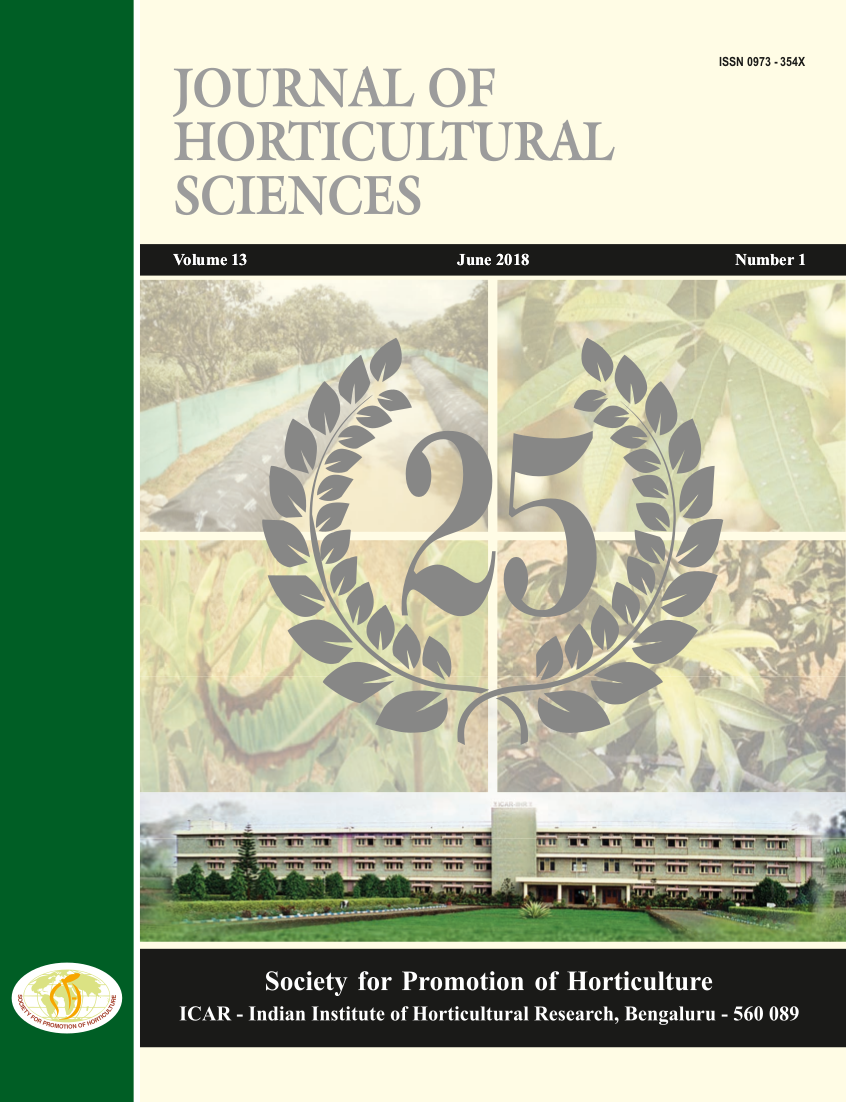Genome wide analysis of heat responsive microRNAs in banana during acquired thermo tolerance
DOI:
https://doi.org/10.24154/jhs.v13i1.35Keywords:
Acquired thermo tolerance, banana, heat stress, miRNA,thermo protective genes.Abstract
MicroRNAs are a class of small regulatory RNAs in plants, which play vital roles during various abiotic and abiotic stress conditions including plant processes. In this present study, we examined the expression of miRNAs and their predicted target expression levels during heat stress in banana. Out of 235 miRNA found in Musa, 40 miRNA showed homology to heat responsive miRNAs from other plants. Further, 14 targets for miRNA were predicted that are potentially regulated by their cognate miRNAs and were monitored under three stages of stress viz, induction, induction + lethal alone using qPCR analysis. The results suggest that generally, there is a negative relationship in the expression patterns of miRNA and their predicted cognate targets - HSP70, HSP90, SAP, DNAj genes. These were highly up regulated and their respective miRNAs showed lower expression. This is the first report in banana, which demonstrated that during induction stress, various thermo-protective genes are activated at initial stages of stress to achieve thermotolerance through altered miRNA expression. The results will help in broadening our understanding acquired thermotolerance and their regulation by miRNAs in plants.
Downloads
References
Balcells, I., Cirera, S. and Busk, P.K. 2011.Specific and sensitive quantitative RT-PCR of miRNAs with DNA primers. BMC Biotechnol., 11: 1 DOI: https://doi.org/10.1186/1472-6750-11-70
Bartel, D.P. 2004. MicroRNAs: genomics, biogenesis, mechanism, and function. Cell., 116: 281-297 DOI: https://doi.org/10.1016/S0092-8674(04)00045-5
Beauclair, L., Yu, A. and Bouche, N. 2010.microRNA directed cleavage and translational repression of the copper chaperone for superoxide dismutase mRNA in Arabidopsis. Plant J., 62: 454-462 DOI: https://doi.org/10.1111/j.1365-313X.2010.04162.x
Bhargava, S. and Sawant, K. 2013. Drought stress adaptation: metabolic adjustment and regulation of gene expression. Plant Breed.,132:21-32 DOI: https://doi.org/10.1111/pbr.12004
Chai, J., Feng, R., Shi, H., Ren, M., Zhang, Y. and Wang, J. 2015.Bioinformatic identification and expression analysis of banana MicroRNAs and their targets. PLoS One., 10: e0123083 DOI: https://doi.org/10.1371/journal.pone.0123083
D’Hont, A., Denoeud, F., Aury, J. M., Baurens, F. C., Carreel, F., Garsmeur,O. and Da, Silva C. 2012.The banana (Musa acuminata) genome and the evolution of monocotyledonous plants. nature.,488: 213-217 DOI: https://doi.org/10.1038/nature11241
Dai, X. and Zhao, P.X. 2011.psRNATarget: a plant small RNA target analysis server. Nucleic Acids Res.,39: 155-159 DOI: https://doi.org/10.1093/nar/gkr319
Davey, M.W., Gudimella, R., Harikrishna, J.A., Sin, L.W., Khalid, N. and Keulemans, W. 2013. A draft Musa balbisiana genome sequence for molecular genetics in polyploid, inter- and intra- specific Musa hybrids. BMC Genomics14:683 DOI: https://doi.org/10.1186/1471-2164-14-683
De, Klerk, G.J., Pumisutapon, P. 2012.Protection of in vitro grown Arabidopsis seedlings against abiotic stresses.Plant Cell Tiss. Org.,95: 149–154 DOI: https://doi.org/10.1007/s11240-008-9426-5
Fujii, H., Chiou, T.J., Lin, S.I., Aung, K., Zhu, J. K. 2005. A miRNA involved in phosphate-starvation response in Arabidopsis. Curr. Biol.,2038-2043 DOI: https://doi.org/10.1016/j.cub.2005.10.016
Gong, M., Li, YJ., Dai, X., Tian, M., & Li, Z.G. 1997. Involvement of calcium and calmodulin in the acquisition of heat-shock induced thermotolerance in maize seedlings. J. Plant. Physiol.,150: 615-621 DOI: https://doi.org/10.1016/S0176-1617(97)80328-8
Larkindale, J. andVierling, E. 2008. Core genome responses involved in acclimation to high temperature. Plant Physiol.,146: 748–761 DOI: https://doi.org/10.1104/pp.107.112060
Lee, WS.,Gudimella, R., Wong, G.R., Tammi, M.T., Khalid, N. &Harikrishna, J.A. 2015. Transcripts and microRNAs responding to salt stress in Musa acuminata Colla (AAA Group) cv. Berangan roots. PLoS ONE.,10: e0127526 DOI: https://doi.org/10.1371/journal.pone.0127526
Lindquist, S. 1986.The heat-shock response.Ann. Rev. Biochem.,55: 1151-1191 DOI: https://doi.org/10.1146/annurev.bi.55.070186.005443
Lopez-Gomollo,S., Mohorianu, I., Szittya, G., Moulton, V. and Dalmay, T. 2012.Diverse correlation patterns between microRNAs and their targets during tomato fruit development indicates different modes of microRNA actions. Planta.,236: 1875-1887 DOI: https://doi.org/10.1007/s00425-012-1734-7
Mallory, A. C. and Vauchere, H. 2006.Functions of microRNAs and related small RNAs in plants. Nat. Genet., 38: 31-36 DOI: https://doi.org/10.1038/ng1791
Park, Y.J., Lee, H.J., Kwak, K. J., Lee, K., Hong, S.W., and Kang, H. 2014. MicroRNA400-guided cleavage of pentatricopeptide repeat protein mRNAs renders Arabidopsis thaliana more susceptible to pathogenic bacteria and fungi. Plant Cell Physiol.,55: 1660–1668 DOI: https://doi.org/10.1093/pcp/pcu096
Palatnik, J. F., Allen, E., Wu, X., Schommer, C., Schwab, R., Carrington, J. C. and Weigel, D. 2003.Control of leaf morphogenesis by microRNAs. Nature., 425: 257-263 DOI: https://doi.org/10.1038/nature01958
Pillai, R.S., Bhattacharyya, S.N., Filipowicz, W. 2007. Repression of protein synthesis by miRNAs: how many mechanisms?.Trends Cell Biol.,17: 118-126 DOI: https://doi.org/10.1016/j.tcb.2006.12.007
Rhoades, M. W., Reinhart, B J., Lim, L. P., Burge, C. B., Bartel, B. and Bartel, D. P. 2002.Prediction of plant microRNA targets. Cell., 110: 513-520 DOI: https://doi.org/10.1016/S0092-8674(02)00863-2
Ruiz-Ferrer, V. and Voinnet, O. 2009. Roles of plant small RNAs in biotic stress responses. Annu. Rev. Plant Biol.,60: 485-510 DOI: https://doi.org/10.1146/annurev.arplant.043008.092111
Schefe, J. H., Lehmann, K. E., Buschmann, I. R., Unger, T., and Funke-Kaiser, H. 2006. Quantitative real-time RT-PCR data analysis: current concepts and the novel “gene expression’s CT difference” formula. J. Mol. Med- JMM.,84: 901-910 DOI: https://doi.org/10.1007/s00109-006-0097-6
Shekhawat, U.K.S., and Ganapathi, T.R. 2015. Engineering Abiotic Stress Tolerance in Transgenic Banana plants by overexpressing Effector/Transcription Factor Genes. (News letter)
Senthil Kumar, M., Srikanthbabu, V., Raju, B. M., Shivaprakash, N. and Udayakumar, M. 2003. Screening of inbred lines to develop a thermotolerant sunflower hybrid using the temperature induction response (TIR) technique: a novel approach by exploiting residual variability. J. Exp. Bot., 54: 2569-2578 DOI: https://doi.org/10.1093/jxb/erg278
Srikanthbabu, V., Krishnaprasad, B. T., Gopalakrishna, R., Savitha, M. and Udayakumar, M. 2002. Identification of pea genotypes with enhanced thermotolerance using temperature induction response technique (TIR). J. Plant. Physiol., 159: 535-545 DOI: https://doi.org/10.1078/0176-1617-00650
Sunkar, R. and Zhu, J. K. 2004.Novel and stress- regulated microRNAs and other small RNAs from Arabidopsis. Plant Cell., 16: 2001-2019 DOI: https://doi.org/10.1105/tpc.104.022830
Sunkar, R., Chinnusamy, V., Zhu, J. and Zhu, J. K. 2007.Small RNAs as big players in plant abiotic stress responses and nutrient deprivation. Trends Plant Sci., 12: 301-309 DOI: https://doi.org/10.1016/j.tplants.2007.05.001
Sunkar, R., Kapoor, A., Zhu, J.K. 2006. Posttranscriptional Induction of Two Cu/Zn Superoxide Dismutase Genes in Arabidopsis Is Mediated by Downregulation of miR398 and Important for Oxidative Stress Tolerance. Plant Cell.,18: 2051-2065 DOI: https://doi.org/10.1105/tpc.106.041673
Vidya, S. M., Laxman, R. H., Bhatt, R. M., Rekha, A., JohnSunoj, V. S., Ravishankar, K.V., 2017. Temperature induction response technique: a screening tool for evaluation of banana cultivars for thermotolerance.Ind .J. Plant Physiol.,22: 79-84 DOI: https://doi.org/10.1007/s40502-016-0273-9
Vidya, S.M., and Ravishankar, K.V. 2016.Molecular mechanism of Heat shock proteins and thermotolerance in plants. N. K. S. Rao (Editor), Abiotic stress physiology of horticultural crops. (DOI: 10.1007/978-81-322-2725-0_4), Springer, New Delhi P 71-83 DOI: https://doi.org/10.1007/978-81-322-2725-0_4
Vidya, S.M., Kumar, H.V., Bhatt, R.M., Laxman, R.H., & Ravishankar, K. V., 2018. Transcriptional profiling and genes involved in acquired thermotolerance in Banana: a non-model crop. Scientific reports, 8(1), 10683. DOI: https://doi.org/10.1038/s41598-018-27820-4
Xie, K., Wu, C., Xiong, L. 2006.Genomic Organization, Differential Expression, and Interaction of SQUAMOSA Promoter-Binding-Like Transcription Factors and microRNA156 in Rice. Plant Physiol.,142: 280-29 DOI: https://doi.org/10.1104/pp.106.084475
Xin, M., Wang, Y., Yao, Y., Song, N., Hu, Z., Qin, D et al., 2011. Identification and characterization of wheat long non-protein coding RNAs responsive to powdery mildew infection and heat stress by using microarray analysis and SBS sequencing. BMC Plant Biol., 11: 1 DOI: https://doi.org/10.1186/1471-2229-11-61
Xin, M., Wang, Y., Yao, Y., Xie, C., Peng, H., Ni, Z. and Sun, Q. 2010. Diverse set of microRNAs are responsive to powdery mildew infection and heat stress in wheat (Triticum aestivum L.). BMC Plant Biol., 10: 123 DOI: https://doi.org/10.1186/1471-2229-10-123
Yu, B. and Wang, H. 2010.Translational inhibition by microRNAs in plants. In miRNA Regulation of the Translational Machinery Springer Berlin Heidelberg., 41-57 DOI: https://doi.org/10.1007/978-3-642-03103-8_3
Yan, K., Liu, P., Wu, C. A., Yang, G. D., Xu, R., Guo, Q. H et al., 2012. Stress-induced alternative splicing provides a mechanism for the regulation of microRNA processing in Arabidopsis thaliana. Mol. Cell., 48: 521-531 DOI: https://doi.org/10.1016/j.molcel.2012.08.032
Zhao, Y. and Srivastava, D. 2007.A developmental view of microRNA function. Trends Biochem. Sci., 32: 189-197 DOI: https://doi.org/10.1016/j.tibs.2007.02.006
Downloads
Published
Issue
Section
License
Copyright (c) 2018 S M Vidya, K V Ravishankar, R H Laxman (Author)

This work is licensed under a Creative Commons Attribution-NonCommercial-ShareAlike 4.0 International License.
Authors retain copyright. Articles published are made available as open access articles, distributed under the terms of the Creative Commons Attribution-NonCommercial-ShareAlike 4.0 International License, which permits unrestricted non-commercial use, distribution, and reproduction in any medium, provided the original author and source are credited. 
This journal permits and encourages authors to share their submitted versions (preprints), accepted versions (postprints) and/or published versions (publisher versions) freely under the CC BY-NC-SA 4.0 license while providing bibliographic details that credit, if applicable.





 .
. 











